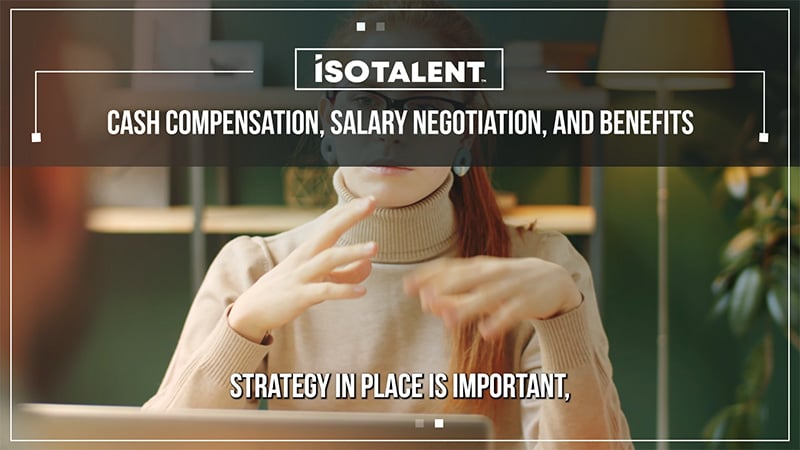HR Benefits: Compelling Packages and Human Capital Strategy
HR Benefits and Compensation Strategy
Home > HR Benefit and Compensation
As integral components of HR strategy, compensation and benefits play a pivotal role in shaping the workplace culture, fostering employee well-being, and ensuring equitable reward structures. Whether you are an HR professional seeking to refine your approach or a business leader eager to optimize your organization's talent management practices, we’re here to offer insights, best practices, and solutions to navigate compensation, salary transparency, and benefit strategies effectively. Here’s how to create compelling, competitive, and holistic rewards that empower your workforce and drive exceptional results.

How to Create a Workplace Employees Love
Foster a positive work environment where employees feel valued, respected, and excited for the road ahead!
HR Benefit Strategies and Compensation FAQs
Overview and Key Terms
A compensation package in HR refers to the combination of salary, wages, bonuses, and other monetary rewards and benefits that an organization offers to its employees in exchange for their work and services. It encompasses both the base pay and variable pay components, such as performance bonuses, commissions, and stock options. The goal of a compensation package is to attract, retain, motivate, and reward employees based on their skills, experience, and performance.
What is a benefits package in HR?
A benefits package in HR includes the non-monetary perks and services that an organization provides to its employees in addition to their regular compensation. Typical benefits may include health insurance, dental and vision coverage, retirement plans, paid time off, wellness programs, and other offerings aimed at improving employees' well-being and work-life balance.
What are "total rewards"?
"Total rewards" is a concept in HR that encompasses all the elements of compensation and benefits offered to employees. It includes both monetary and non-monetary rewards, such as salary, bonuses, healthcare, retirement plans, work-life balance programs, recognition, and career development opportunities. The goal of a total rewards strategy is to create a comprehensive and attractive compensation package that aligns with organizational objectives and motivates employees to perform at their best.
Are You Losing the Talent War?
What are the primary objectives of a benefits package?
The primary objectives of a benefits package in HR include:
- Attracting and retaining top talent.
- Promoting employee health and well-being.
- Enhancing job satisfaction and work-life balance.
- Complying with legal and regulatory requirements.
- Supporting diversity and inclusion initiatives.
- Increasing employee morale and loyalty.
- Differentiating the organization in the competitive job market.
How do you effectively communicate benefits offerings to employees?
To effectively communicate benefits offerings to employees, HR can:
- Create clear and comprehensive benefits guides.
- Host benefits orientation sessions for new hires.
- Use various communication channels, such as emails, intranet, and printed materials.
- Conduct regular benefits education and Q&A sessions.
- Provide personalized support to help employees choose the right benefits for their needs.
- Utilize technology, like benefits portals, to allow employees to access information easily.
Should we implement flexible benefits packages?
Implementing flexible benefits packages can be advantageous as they allow employees to choose benefits that align with their individual needs and preferences. Flexible packages can enhance employee satisfaction and retention. However, it's essential to design and communicate these packages effectively to ensure employees understand their choices and make informed decisions.
How should our team recognize high performers with our benefits and comp package?
To recognize high performers within benefits and compensation packages, organizations can:
- Offer performance-based bonuses and incentives.
- Provide career advancement opportunities and promotions.
- Consider individualized compensation adjustments or merit increases.
- Include special recognition programs or awards tied to performance metrics.
- Offer additional non-monetary rewards, such as extra paid time off or access to premium benefits.
- Maintain open communication to discuss career development paths and align rewards with individual goals.
Recognition within the benefits and compensation package should be closely tied to an employee's contributions and alignment with the organization's goals and values.
What is pay equity?
Pay equity refers to the principle of ensuring that individuals are paid fairly and equally for performing work of equal value, regardless of their gender, race, ethnicity, or other protected characteristics. It aims to eliminate wage gaps and discrimination in compensation by ensuring that employees receive equal pay for equal work or work of comparable worth. Pay equity is an important aspect of promoting diversity, inclusion, and fairness in the workplace.
How can you offer competitive pay without budget?
Offering competitive pay when you have budget constraints can be challenging but not impossible. Strategies include:
- Conducting market research to identify salary ranges for your industry and region.
- Prioritizing key positions or critical roles for competitive compensation.
- Offering non-monetary incentives, such as flexible work arrangements, professional development, and work-life balance programs.
- Reviewing and optimizing your existing compensation structure to reallocate funds.
- Implementing performance-based pay increases or bonuses tied to organizational goals.
- Exploring cost-effective benefits options, such as wellness programs or telecommuting, to enhance the overall compensation package.
Why Do Some Industries Struggle to Retain Top Talent?
What is salary transparency?
Salary transparency is the practice of openly communicating information about compensation structures and pay rates within an organization. It involves sharing salary ranges, pay scales, and the factors considered in determining an employee's compensation. The goal of salary transparency is to foster trust, fairness, and openness in the workplace, reduce pay gaps, and ensure that employees have a clear understanding of how their pay is determined.
What are non-monetary incentives?
Non-monetary incentives are rewards or benefits offered to employees that do not involve direct financial compensation. These incentives are designed to motivate, engage, and recognize employees for their contributions. Examples of non-monetary incentives include:
- Flexible work arrangements, such as remote work or flexible hours.
- Professional development opportunities, including training, workshops, and conferences.
- Recognition and appreciation programs, such as employee of the month awards.
- Career advancement opportunities and mentorship programs.
- Wellness programs, health benefits, and access to fitness facilities.
- Additional paid time off or extended vacation days.
- Employee assistance programs (EAPs) for mental health and well-being support.
Non-monetary incentives are valuable tools for enhancing employee satisfaction, engagement, and retention, especially when financial resources are limited. They can help create a positive work environment and improve overall job satisfaction without increasing direct compensation costs.
How to Support Your Employees During Soaring Inflation
HR Benefits
What are the primary objectives of a benefits package?
The primary objectives of a benefits package in HR include:
- Attracting and retaining top talent.
- Promoting employee health and well-being.
- Enhancing job satisfaction and work-life balance.
- Complying with legal and regulatory requirements.
- Supporting diversity and inclusion initiatives.
- Increasing employee morale and loyalty.
- Differentiating the organization in the competitive job market.
How do you effectively communicate benefits offerings to employees?
To effectively communicate benefits offerings to employees, HR can:
- Create clear and comprehensive benefits guides.
- Host benefits orientation sessions for new hires.
- Use various communication channels, such as emails, intranet, and printed materials.
- Conduct regular benefits education and Q&A sessions.
- Provide personalized support to help employees choose the right benefits for their needs.
- Utilize technology, like benefits portals, to allow employees to access information easily.
Should we implement flexible benefits packages?
Implementing flexible benefits packages can be advantageous as they allow employees to choose benefits that align with their individual needs and preferences. Flexible packages can enhance employee satisfaction and retention. However, it's essential to design and communicate these packages effectively to ensure employees understand their choices and make informed decisions.
How should our team recognize high performers with our benefits and comp package?
To recognize high performers within benefits and compensation packages, organizations can:
- Offer performance-based bonuses and incentives.
- Provide career advancement opportunities and promotions.
- Consider individualized compensation adjustments or merit increases.
- Include special recognition programs or awards tied to performance metrics.
- Offer additional non-monetary rewards, such as extra paid time off or access to premium benefits.
- Maintain open communication to discuss career development paths and align rewards with individual goals.
Recognition within the benefits and compensation package should be closely tied to an employee's contributions and alignment with the organization's goals and values.
Compensation
What is pay equity?
Pay equity refers to the principle of ensuring that individuals are paid fairly and equally for performing work of equal value, regardless of their gender, race, ethnicity, or other protected characteristics. It aims to eliminate wage gaps and discrimination in compensation by ensuring that employees receive equal pay for equal work or work of comparable worth. Pay equity is an important aspect of promoting diversity, inclusion, and fairness in the workplace.
How can you offer competitive pay without budget?
Offering competitive pay when you have budget constraints can be challenging but not impossible. Strategies include:
- Conducting market research to identify salary ranges for your industry and region.
- Prioritizing key positions or critical roles for competitive compensation.
- Offering non-monetary incentives, such as flexible work arrangements, professional development, and work-life balance programs.
- Reviewing and optimizing your existing compensation structure to reallocate funds.
- Implementing performance-based pay increases or bonuses tied to organizational goals.
- Exploring cost-effective benefits options, such as wellness programs or telecommuting, to enhance the overall compensation package.
Why Do Some Industries Struggle to Retain Top Talent?
What is salary transparency?
Salary transparency is the practice of openly communicating information about compensation structures and pay rates within an organization. It involves sharing salary ranges, pay scales, and the factors considered in determining an employee's compensation. The goal of salary transparency is to foster trust, fairness, and openness in the workplace, reduce pay gaps, and ensure that employees have a clear understanding of how their pay is determined.
What are non-monetary incentives?
Non-monetary incentives are rewards or benefits offered to employees that do not involve direct financial compensation. These incentives are designed to motivate, engage, and recognize employees for their contributions. Examples of non-monetary incentives include:
- Flexible work arrangements, such as remote work or flexible hours.
- Professional development opportunities, including training, workshops, and conferences.
- Recognition and appreciation programs, such as employee of the month awards.
- Career advancement opportunities and mentorship programs.
- Wellness programs, health benefits, and access to fitness facilities.
- Additional paid time off or extended vacation days.
- Employee assistance programs (EAPs) for mental health and well-being support.
Non-monetary incentives are valuable tools for enhancing employee satisfaction, engagement, and retention, especially when financial resources are limited. They can help create a positive work environment and improve overall job satisfaction without increasing direct compensation costs.
How to Support Your Employees During Soaring Inflation
What Are the Fundamentals of Benefits and Compensation Strategy for HR?
Navigating the intricate realm of Human Resources demands a nuanced understanding of the fundamentals that underpin the design and execution of effective benefits and compensation strategies. In today's competitive job market, attracting and retaining top talent while nurturing a thriving workplace culture hinges on these critical HR pillars.
The journey begins with a comprehensive grasp of "compensation" – encompassing the monetary rewards that employees receive for their invaluable contributions. From salaries and bonuses to incentives and raises, compensation serves as a vital tool for motivating and retaining a talented workforce.
But the story doesn't end there. "Benefits" extend beyond monetary compensation, offering a holistic approach to enhancing employee well-being. These encompass health and wellness programs, retirement plans, work-life balance initiatives, and a host of other non-monetary perks that enrich the employee experience.
To navigate this multifaceted terrain successfully, HR professionals must delve into the intricacies of pay equity, balance competitive offerings within budget constraints, embrace transparency in salary practices, and harness the power of non-monetary incentives. Our exploration into the fundamentals of benefits and compensation strategy for HR embarks on a journey that empowers organizations to not only attract high-quality talent but also create an environment where employees thrive, driving the success of the entire organization. Let’s delve deeper into the strategies, insights, and best practices that define this essential HR discipline.
- Total Rewards Perspective: HR leaders should shift their focus from merely offering competitive salaries to adopting a holistic "total rewards" perspective. This approach considers not only base pay but also benefits, bonuses, equity, and non-monetary rewards like career development opportunities and work-life balance. It recognizes that employees value a comprehensive package that enhances their overall well-being.
- Customized Benefits: Leaders might underestimate the value of customized benefits packages. Rather than offering one-size-fits-all benefits, organizations should consider tailoring options to meet the diverse needs of their workforce. This could involve flexible work arrangements, personalized health plans, or wellness programs that address specific employee demographics.
- Transparency in Compensation: Transparency in compensation practices is vital. Many organizations keep salary information confidential, leading to misconceptions and frustration among employees. Transparency can foster trust and help employees understand how their compensation aligns with performance, industry benchmarks, and the organization's compensation philosophy.
- Equity and Pay Equity: Pay equity is not just a compliance issue; it's a strategic imperative. HR leaders should proactively address gender and minority pay gaps by conducting regular pay equity audits. Beyond legal compliance, this contributes to a fairer, more inclusive workplace and strengthens the organization's reputation.
- Communication and Education: Leaders often overlook the importance of effective communication and education regarding benefits and compensation. Employees may not fully understand the value of their benefits package or how to optimize it. Regular, clear communication and educational initiatives can help employees make informed choices and appreciate the full scope of their compensation.
- Employee Well-Being Initiatives: Employee well-being extends beyond compensation. Leaders can enhance well-being by offering mental health programs, stress management resources, and initiatives that promote work-life balance. These efforts contribute to a healthier, happier, and more engaged workforce.
- Retention and Attraction Strategy: Effective benefits and compensation strategies can be powerful retention and attraction tools. HR leaders should continuously evaluate the effectiveness of their packages in retaining top talent and attracting new employees. Surprisingly, offering unique perks like flexible scheduling or sabbaticals can set an organization apart.
- Leveraging Technology: Technology can streamline benefits administration and compensation management. HR leaders should explore integrated HR technology solutions that not only reduce administrative burdens but also provide employees with easy access to information and self-service options.
- Benchmarking and Market Trends: Keeping an eye on market trends and compensation benchmarking is essential. Leaders should regularly assess their compensation packages against industry standards to ensure they remain competitive and in line with market trends.
Learn About Benefits Benchmarking - Incentive Structures: Incentive structures can significantly impact performance. Leaders can implement creative incentives, such as spot bonuses, profit-sharing, or peer recognition programs, to motivate employees and align their efforts with organizational goals.
HR leaders can enhance their approach to benefits and compensation by adopting a total rewards perspective, customizing packages, prioritizing transparency, focusing on equity, improving communication and education, promoting employee well-being, leveraging technology, staying competitive, and implementing innovative incentives. These strategies contribute to holistic outcomes that not only attract and retain talent but also create a positive and thriving workplace culture.

What Questions Should an HR Team Ask to Assess their Compensation and Benefits Strategy?
These are questions to guide your Compensation and Benefits strategy and tease out more actionable insights from your team:
- Are our current compensation structures aligned with our organizational goals and industry benchmarks?
- How often do we conduct pay equity audits to ensure fairness and equity in compensation?
- Do our benefits packages address the diverse needs and preferences of our workforce?
- Are we effectively communicating the full scope and value of our benefits to employees?
- What initiatives do we have in place to promote employee financial wellness and stability?
- How do we assess the impact of our compensation and benefits on employee retention and attraction?
- Are our compensation practices transparent, and do employees understand how their pay is determined?
- Do our benefits offerings support employee well-being, including mental health and work-life balance?
- What measures are in place to address any pay gaps or disparities among different employee groups?
- How do we stay updated on compensation trends and industry standards to remain competitive?
- What technology tools or software do we use to streamline compensation and benefits administration?
- Are we offering creative and meaningful incentives that align with our organizational goals?
- How do we evaluate the effectiveness of our benefits and compensation in enhancing employee satisfaction and engagement?
- What strategies do we have to manage the costs of benefits and compensation without sacrificing quality?
- How can we tailor our benefits and compensation packages to better support our employees' overall well-being and career development aspirations?
Download these Questions for Quick Reference
In the dynamic landscape of human resources, crafting a well-rounded compensation and benefits strategy is paramount for organizations striving to attract and retain top talent while fostering a positive workplace culture. Understanding the principles of pay equity, offering competitive rewards within budget constraints, embracing salary transparency, and leveraging non-monetary incentives are essential components of this endeavor. But the true power lies in recognizing the potential of "total rewards" – a holistic approach that combines both monetary and non-monetary offerings to enhance employee engagement and satisfaction.
As you navigate how benefits and compensation play a role in recruitment, our team of hiring experts are ready to provide you with the insights and strategies needed to connect with high-quality candidates and communicate the unique value of your organization. Our recruiters can help you shape a compensation and benefits strategy that not only attracts exceptional talent but also empowers your company to thrive in an increasingly competitive talent market. Reach out for a free comp data report to get started!

© 2025 IsoTalent, Inc. All rights reserved. IsoTalent Recruiting | 1 (877) 619 3486
2600 Executive Pkwy Suite 380, Lehi, UT 84043

